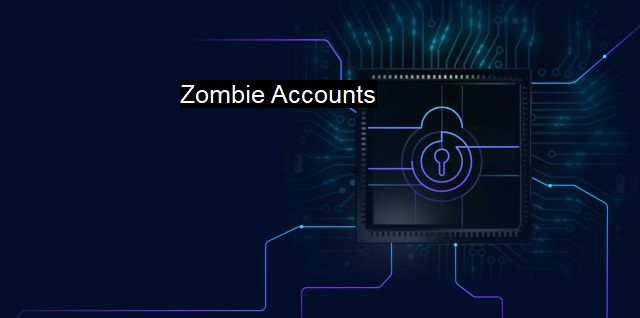What are Zombie Accounts?
The Grave Danger of Zombie Accounts in Cyberspace: How Neglecting Inactive Accounts Can Put Users' Data At Risk
Zombie accounts refer to the user accounts left inactive, unattended, and unmanaged for an extended period in the cyber world. Some of these accounts are those abandoned by the users who have switched to other platforms, changed jobs, or just left them idle. Other zombie accounts include employee accounts that are not closed after leaving the company. These accounts, often forgotten in the realms of the digital world, pose serious security risks and are potential gold mines for hackers worldwide.Although innocent in appearance, these inactive accounts can be exploited to unleash several cybersecurity threats. Hackers often target these accounts because they are easiest to infiltrate due to their dormancy, the absence of regular security updates, weaker passwords, or outdated multi-factor authentication methods.
Once hackers gain access to these zombie accounts, they can use them as an entry point to compromise other active accounts on the same network or gain access to critical data. these accounts can become a vehicle to transfer malware across networks, create synthetic identities for fraud, boost website traffic to certain websites, manipulate social media influence, and serve as launch pads for any illicit activities, incognito. Besides, a successful breach into these accounts allows hackers to disguise their own identity. To the advent of an investigation, to the eyes of the network logs, the activity would appear as though original user were performing them.
Solving zombie accounts issue goes beyond simple password protection or frequently changing them. It needs proper account management system. Companies need to rigorously monitor the network for any accounts that have gone dormant, frequently update their security measures, employ auto sweep or account lock-out regulations for inactive accounts, and define a policy dictating when inactive accounts should be deleted. Employee-offboarding process should include timely deactivation of employees’ accounts.
In contrast to the traditional phishing attacks where responses are expected almost immediately once launched, hackers with access to zombie accounts work patiently and slowly, letting the malicious seed grow undetected. That's why catching these infiltrations can become difficult. Cybersecurity firms suggest using behavior-based network monitoring to detect unusual or suspicious activities in the systems and helps to identify zombie accounts. Other efficient practices include a periodic audit to identify unused applications, redundant accounts, clarifying ownership, and intended usage.
The use of real-time dashboards that often come with Security Information & Event Management (SIEM) technologies can also go a long way in managing zombie accounts. It is also beneficial to incorporate efficient User Activity Monitoring (UAM) software that aids in operating regular surveillance on what is happening across your IT systems.
Zombie accounts are also a significant challenge for social media platforms like Twitter and Facebook and professional sites like Linkedin. These platforms are filled with numerous inactive accounts, some of them only used once or twice and then forgotten. This increased number of zombie accounts skews the active user metrics and diminishes the business value of these platforms.
Antivirus software plays a pivotal role in the prevention of zombie account creation. A strong antivirus can avert the infiltration of a bot or a virus into user's system which can be potentially used to create zombie accounts; it can detect any suspicious activity, prevent user system's involvement in a botnet, and hence protect the user from becoming an inadvertent accomplice in a cyberattack.
In our quest for ensured data safety and cyber security, recognizing the detrimental potential that zombie accounts carry is vital, as, in the words of Craig McDonald, CEO at MailGuard, this scenario is nothing less than "ghosts who are trying to rob a bank." In the world of artificial intelligence and escalating cyber frauds, adopting prompt account management and stringent de-provisioning process are more important than ever to tackle these incubators of cyber threats effectively.

Zombie Accounts FAQs
What are zombie accounts?
Zombie accounts are compromised user accounts that have been taken over by a cybercriminal. These accounts are used to conduct malicious activities such as sending out spam emails, phishing attacks and spreading malware.How are zombie accounts created?
Zombie accounts are created through various means such as phishing attacks, brute-force attacks, and password cracking techniques. Cybercriminals use various tactics to gain access to user accounts and take control of them.What are the risks associated with zombie accounts?
Zombie accounts can pose various risks to users and organizations. They can be used to spread malware, steal sensitive information, and conduct fraudulent activities. Zombie accounts can also damage the reputation of an organization and lead to financial losses.How to protect against zombie accounts?
To protect against zombie accounts, users should use strong passwords, enable two-factor authentication, and regularly monitor their accounts for any suspicious activities. Organizations should also implement security measures such as firewalls, antivirus software, and intrusion detection systems to prevent and detect unauthorized access to user accounts.| | A | | | B | | | C | | | D | | | E | | | F | | | G | | | H | | | I | | | J | | | K | | | L | | | M | |
| | N | | | O | | | P | | | Q | | | R | | | S | | | T | | | U | | | V | | | W | | | X | | | Y | | | Z | |
| | 1 | | | 2 | | | 3 | | | 4 | | | 7 | | | 8 | | |||||||